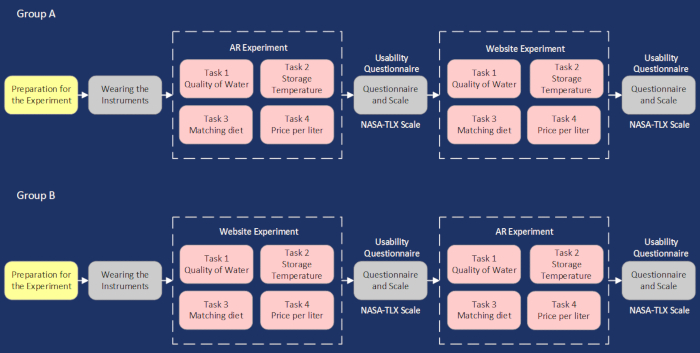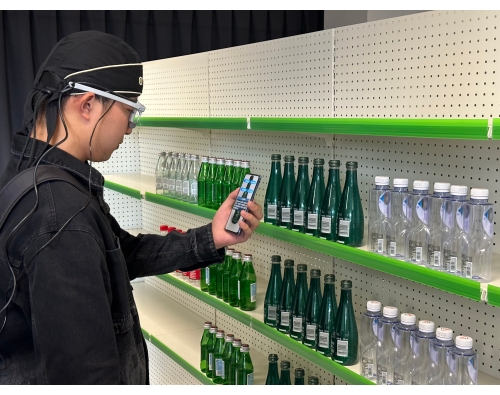增强现实的可用性评估:神经信息系统研究
Summary
本研究提出了一种结合主观和客观评估的可用性测试的实验范式。客观评估采用神经信息系统(NeuroIS)方法,主观评估采用可用性问卷和NASA任务负荷指数(NASA-TLX)量表。
Abstract
本研究介绍了管理信息系统(MIS)中新兴技术可用性测试的实验范式。可用性测试包括主观和客观评估。对于主观评估,采用了可用性问卷和NASA-TLX量表。为了进行客观评估,使用了神经信息系统(NeuroIS)的方法。从NeuroIS的角度来看,本研究使用移动fNIRS和眼动追踪眼镜进行多模态测量,解决了真实世界行为实验中使用的认知神经科学工具的生态有效性问题。这项研究使用集成到物联网(IoT)中的增强现实(AR)作为实验对象。比较两种信息搜索模式(AR与网站)在神经影像数据、生理数据、可用性问卷和NASA-TLX量表数据方面的差异,AR信息搜索在消费决策过程中与网站信息搜索相比,效率更高,认知负荷更低。可用性实验结果表明,AR作为零售业的新兴技术,可以有效提升消费者体验,增加消费者购买意愿。本研究中结合主观和客观评估的实验范式可以应用于新兴技术的可用性测试,例如增强现实、虚拟现实、人工智能、可穿戴技术、机器人和大数据。它为采用新兴技术的人机交互中的用户体验提供了实用的实验解决方案。
Introduction
以增强现实、虚拟现实、人工智能、可穿戴技术、机器人和大数据为代表的六种与消费者互动的前沿技术正在重塑消费者行为的许多理论模型1。增强现实(AR)是一项新技术,可以增强消费者体验并提高消费者满意度。它将文本信息、图像、视频等虚拟物品叠加到真实场景中,融合虚拟与现实,从而通过解释、引导、评估和预测来增强现实世界中的信息2.AR提供了一种新型的人机交互,为消费者创造了身临其境的购物体验,并导致了许多应用的发展3,4。然而,消费者对AR服务的接受度仍然很低,因此许多公司对采用AR技术持谨慎态度5,6。技术接受模型(TAM)已被广泛用于解释和预测新信息技术的采用行为7,8。根据TAM的说法,新技术的采用意图在很大程度上取决于其可用性9。因此,从TAM的角度来看,消费者对AR服务的接受速度缓慢的可能解释可能与新技术的可用性有关,这突出了在购物时评估AR可用性的必要性10,11。
可用性被定义为指定用户在指定上下文中实现指定目标的有效性、效率和满意度12.目前,评估可用性有两种主要方法:主观评估和客观评估13.主观评价主要依靠使用问卷和量表的自我报告方法。根据这一研究思路,本研究中使用的问卷包括与信息搜索模式相关的五个特征,以实现目标:(1)效率,(2)易用性,(3)记忆力(易于记忆),(4)满意度(信息搜索模式舒适愉快),以及(5)对其他对象的普遍性14,15,16.此外,认知负荷,表示在学习者17的认知系统上执行特定任务时的负荷,是可用性的另一个核心指标18,19。因此,这项研究还使用了NASA任务负荷指数(NASA-TLX)13,20作为主观指标来衡量使用AR购物与使用网站服务购物时的认知负荷。值得注意的是,自我报告方法依赖于个人准确报告其态度和/或先前行为的能力和意愿21,从而留下了错误报告,少报或偏见的可能性。因此,客观措施可以作为传统主观方法的宝贵补充22.
神经信息系统(NeuroIS)方法用于客观评估AR的可用性。NeuroIS由Dimoka等人在2007年ICIS会议上创造,在信息系统(IS)领域引起了越来越多的关注23。NeuroIS使用认知神经科学的理论和工具来更好地了解IS技术的发展,采用和影响24,25。迄今为止,认知神经科学工具,如功能磁共振成像(fMRI),脑电图(EEG),正电子发射计算机断层扫描,脑磁图(MEG)和功能近红外光谱(fNIRS),通常用于NeuroIS研究26,27。例如,Dimoka和Davis使用fMRI来测量受试者与网站互动时的激活,并揭示了感知易用性会影响前额叶皮层(PFC)的激活28。同样,使用脑电图,Moridis等人发现额叶不对称与有用性密切相关29。这些结果表明,PFC可能在可用性中起关键作用。
尽管在以前的NeuroIS研究中已经取得了成就,但这些研究中使用的范式限制了生态有效性低的受试者的身体运动,限制了他们的理论和实践贡献。在购物时与AR等技术互动需要自由的身体运动,而主题限制在很大程度上损害了消费者体验,如He等人22所讨论的那样。因此,需要具有高生态有效性的脑成像工具进行信息系统的可用性测试。在这方面,fNIRS具有独特的技术优势:在fNIRS实验中,受试者可以在一定程度上自由移动30 。例如,以前的研究已经测量了受试者在几种户外活动中的大脑激活,例如使用便携式fNIRS31骑自行车。此外,fNIRS成本低廉,能够长时间测量大脑激活32。在这项研究中,fNIRS用于客观地测量受试者在使用AR与网站的购物服务时的认知负荷水平。
近年来,眼动追踪已成为一种有价值的心理生理学技术,用于在可用性测试中检测用户的视觉注意力33,并且还广泛用于NeuroIS研究34。该技术依赖于眼睛 – 心灵假设,该假设观察者的焦点到达注意力所指向的地方,视觉注意力代表心理过程,视觉注意力模式反映人类认知策略35,36,37。在AR研究领域,Yang等人使用眼动追踪发现AR广告通过增加消费者的好奇心和注意力来改善消费者对广告的态度38。在目前的研究中,眼动追踪用于测量受试者的注意力,包括总注视持续时间、平均注视持续时间、注视频率、扫视频率、平均扫视持续时间和平均扫描路径长度等参数。
综上所述,本研究提出了一种以AR应用相结合的主观客观评价的可用性测试方法。使用可用性问卷和NASA-TLX量表进行主观评估,并使用fNIRS和眼动追踪相结合的多模态测量进行客观评估39,40。
试验设计
实验材料:为了模拟现实生活中的购物环境,在实验室中搭建了一个产品架,并在货架上放置了两种不同品牌的矿泉水作为实验材料。选择矿泉水作为必需品,是因为参与者不会因职业背景、性别和购买能力而在主观评估中产生偏见。控制品牌的价格、产能和熟悉度(见 材料表),以消除不相关变量的干扰。
可用性测试包括两个条件:基于智能手机的AR应用程序(补充图1)和网站(补充图2)。AR应用程序是基于AR引擎编程的。该网站是使用Python开发的,前端基于Bootstrap,后端基于Flask。AR应用程序和网站在智能手机上运行和浏览。在两种不同品牌的矿泉水中,一种在AR条件下用作实验材料,另一种在网站条件下使用。
实验任务:参与者被要求执行来自物联网应用环境的四个信息搜索任务:水质、储存温度、匹配饮食和每升价格。这四个信息项是消费者在购买矿泉水时通常会注意的。参与者完成任务没有时间限制。
水质:矿泉水的质量通常包括两个指标:总溶解固体(TDS)和pH值。TDS反映矿物质含量,pH值描述水的酸度/碱度。这两个指标与矿泉水中含有的微量元素有关,影响口感。例如,Bruvold和Ongerth根据其TDS含量41将水的感官质量分为五个等级。Marcussen等人发现,水具有良好的感官品质,范围为100-400毫克/升TDS42。本研究中使用的两个品牌矿泉水的TDS和pH值分别使用TDS和pH计测量,然后在AR应用程序和网站上标记。在执行任务时,参与者需要报告矿泉水的TDS和pH值,并确认这些值是否在标称范围内。在AR条件下,参与者可以通过扫描瓶装水来获取此信息。在网站条件下,参与者需要执行四个步骤:(1)在矿泉水瓶背面找到数字代码,(2)在查询框中输入数字代码以获取矿泉水的TDS和pH值,(3)在网站上搜索矿泉水的标称范围,以及(4)口头报告TDS和pH值是否在产品的标称范围内。
储存温度:由于温度的变化,矿泉水的质量在运输和储存过程中可能会下降。实验表明,矿泉水在运输和储存过程中的适宜温度在5°C至25°C之间。在这个温度范围内,水没有难闻的气味43。在本实验中,在AR应用程序和网站上标记了两种矿泉水在不同地方的储存温度。在执行任务时,参与者需要报告水的储存位置和相应的温度。在AR条件下,参与者可以通过扫描瓶装水来获取此信息。在网站条件下,参与者可以通过在查询框中输入数字代码来获取此信息。
搭配饮食:不同品牌的矿泉水因其独特的矿物质成分和气泡含量而适合不同的菜单44.在本实验中,两种矿泉水的饮食建议在AR应用程序和网站上进行了标记。在执行任务时,参与者被要求报告矿泉水如何与菜单中的食物相匹配。在AR条件下,参与者可以通过扫描水瓶来获取此信息。在网站条件下,参与者可以在网站上搜索此信息。
每升价格:目前,中国矿泉水瓶上的标签不显示每升价格信息。这使得消费者难以区分不同类型矿泉水的单价差异。因此,本实验要求参与者报告每升价格。在AR应用程序中,参与者可以通过扫描瓶装水直接获得每升的价格。在网站条件下,可以根据标签上的单价和数量计算信息。
本研究采用受试者内设计,受试者纳入和排除标准如 表1所述。共有40名参与者完成了实验(20名男性和20名女性,平均年龄= 21.31±1.16岁)。所有参与者均为江苏科技大学本科生,随机分为两组(A组和B组)。为了避免顺序效应,实验顺序在两组之间进行了平衡(A / B)。具体来说,一组先执行AR条件,然后执行网站条件,而另一组先执行网站,然后执行AR条件。参与者被要求完成实验准备,佩戴仪器,并执行实验任务。实验间隔设置为10 s,以允许皮质激活恢复到基线水平,避免后续任务中的交叉影响。在AR/网站实验结束时,参与者被要求完成可用性问卷和NASA-TLX量表。实验流程图如图 1所示。实验设置的照片如图 2所示。
表1:研究的纳入和排除标准。请按此下载此表格。

图 1:实验流程图。每个实验持续~45分钟,任务之间的休息时间为10秒。请点击此处查看此图的大图。

图 2:实验场景的示例设置。 展示了实验材料、参与者和设备。 请点击此处查看此图的大图。
Protocol
Representative Results
Discussion
协议中的关键步骤
在实验过程中,考虑了几个步骤以确保结果的可靠性。首先,熟悉实验中使用的矿泉水品牌的参与者被排除在外,因为这些参与者会根据他们对品牌的了解来执行任务。其次,参与者使用其他品牌的矿泉水完成了预实验,以确保参与者熟悉AR和网站操作。第三,佩戴fNIRS探头时,使用黑色头巾覆盖探头,以保护探头免受环境光照射并提高信号质量。第四,佩戴隐形…
Disclosures
The authors have nothing to disclose.
Acknowledgements
本研究得到了江苏省教育厅哲学社会科学研究项目(2018SJA1089)、江苏省政府海外研究奖学金(JS-2018-262)、浙江省自然科学基金(LY19G020018)和国家自然科学基金(72001096)的支持。
Materials
| AR Engine | Unity Technologies | 2020.3.1 | AR development platform |
| AR SDK | PTC | Vuforia Engine 9.8.5 | AR development kit |
| Eye Tracker (eye tracking glasses) | SMI, Germany | SMI ETG | Head-mounted eye tracking system |
| Eye Tracker Recording software | SMI, Germany | iViewETG Software | Eye Tracker Recording software |
| fNIRS probes | Artinis Medical Systems BV, Netherlands | Artinis PortaLite | Light source: Light emitting diodes Wavelengths: Standard nominal 760 and 850 nm |
| fNIRS software | Artinis Medical Systems BV, Netherlands | OxySoft 3.2.70 | fNIRS data recording and analysis software |
| Mineral Water | Groupe Danone | Badoit | Experimental material in the AR condition Capacity: 330ml Price:  6 6 |
| Mineral Water | Nestlé | Acqua Panna | Experimental material in the website condition Capacity: 250ml Price:  5.4 5.4 |
| Skin Preparation Gel | Weaver and Company | Nuprep | Clean the forehead skin of the participants |
| Smartphone | Xiaomi | Redmi K30 Ultra | Smartphone-based AR application and website |
References
- Ameen, N., Hosany, S., Tarhini, A. Consumer interaction with cutting-edge technologies: Implications for future research. Computers in Human Behavior. 120, 106761 (2021).
- Javornik, A. Augmented reality: Research agenda for studying the impact of its media characteristics on consumer behaviour. Journal of Retailing and Consumer Services. 30, 252-261 (2016).
- Caboni, F., Hagberg, J. Augmented reality in retailing: a review of features, applications and value. International Journal of Retail & Distribution Management. 47 (11), 1125-1140 (2019).
- Kumar, H. Augmented reality in online retailing: a systematic review and research agenda. International Journal of Retail & Distribution Management. 50 (4), 537-559 (2022).
- Yim, M. Y. C., Park, S. Y. I am not satisfied with my body, so I like augmented reality (AR): Consumer responses to AR-based product presentations. Journal of Business Research. 100, 581-589 (2019).
- Chylinski, M., et al. Augmented reality marketing: A technology-enabled approach to situated customer experience. Australasian Marketing Journal. 28 (4), 374-384 (2020).
- Davis, F. D. . A Technology Acceptance Model for Empirically Testing New End-User Information Systems: Theory and Results. , (1985).
- Venkatesh, V., Morris, M. G., Davis, G. B., Davis, F. D. User acceptance of information technology: Toward a unified view. MIS Quarterly. 27 (3), 425-478 (2003).
- Davis, F. D. Perceived usefulness, perceived ease of use, and user acceptance of information technology. MIS Quarterly. 13 (3), 319-340 (1989).
- Chen, R., Perry, P., Boardman, R., McCormick, H. Augmented reality in retail: a systematic review of research foci and future research agenda. International Journal of Retail & Distribution Management. 50 (4), 498-518 (2022).
- Poushneh, A., Vasquez-Parraga, A. Z. Discernible impact of augmented reality on retail customer’s experience, satisfaction and willingness to buy. Journal of Retailing and Consumer Services. 34, 229-234 (2017).
- ISO. ISO 1998. Ergonomic requirements for office work with visual display terminals (VDTs)-Part 11: guidance on usability. ISO. , (2022).
- Hornbæk, K. Current practice in measuring usability: Challenges to usability studies and research. International Journal of Human-Computer Studies. 64 (2), 79-102 (2006).
- Tullis, T., Albert, B. . Measuring the User Experience: Collecting, Analyzing, and Presenting Usability Metrics. , (2008).
- Shneiderman, B., Plaisant, C., Cohen, M., Jacobs, S. M., Elmqvist, N. . Designing the User Interface: Strategies for Effective Human-Computer Interaction. , (2017).
- Morillo, P., Orduña, J. M., Casas, S., Fernández, M. A comparison study of AR applications versus pseudo-holographic systems as virtual exhibitors for luxury watch retail stores. Multimedia Systems. 25 (4), 307-321 (2019).
- Paas, F. G., Van Merriënboer, J. J. Instructional control of cognitive load in the training of complex cognitive tasks. Educational Psychology Review. 6 (4), 351-371 (1994).
- Ismail, R., Fabil, N., Saleh, A. Extension of pacmad model for usability evaluation metrics using goal question metrics (Gqm) approach. Journal of Theoretical and Applied Information Technology. 79 (1), 90-100 (2015).
- Fan, X., Chai, Z., Deng, N., Dong, X. Adoption of augmented reality in online retailing and consumers’ product attitude: A cognitive perspective. Journal of Retailing and Consumer Services. 53, 101986 (2020).
- Hart, S. G., Staveland, L. E. Development of NASA-TLX (Task Load Index): Results of empirical and theoretical research. Advances in Psychology. 52, 139-183 (1988).
- Petty, R. E., Cacioppo, J. T., Schumann, D. Central and peripheral routes to advertising effectiveness: The moderating role of involvement. Journal of Consumer Research. 10 (2), 135-146 (1983).
- He, L., Pelowski, M., Yu, W., Liu, T. Neural resonance in consumers’ right inferior frontal gyrus predicts attitudes toward advertising. Psychology & Marketing. 38 (9), 1538-1549 (2021).
- Riedl, R., Fischer, T., Léger, P. M., Davis, F. D. A decade of NeuroIS research: Progress, challenges, and future directions. ACM SIGMIS Database: the DATA BASE for Advances in Information Systems. 51 (3), 13-54 (2020).
- Vom Brocke, J., Liang, T. P. Guidelines for Neuroscience Studies in Information Systems Research. Journal of Management Information Systems. 30 (4), 211-234 (2014).
- Dimoka, A., Pavlou, P. A., Davis, F. NeuroIS: The potential of cognitive neuroscience for information systems research. Information Systems Research. 22 (4), 687-702 (2011).
- de Guinea, A. O., Titah, R., Léger, P. M. Explicit and implicit antecedents of users’ behavioral beliefs in information systems: A neuropsychological investigation. Journal of Management Information Systems. 30 (4), 179-210 (2014).
- Dimoka, A. How to conduct a Functional Magnetic Resonance (fmri) study in social science research. MIS Quarterly. 36 (3), 811-840 (2012).
- Dimoka, A., Davis, F. D. Where does TAM reside in the brain? The neural mechanisms underlying technology adoption. ICIS 2008 Proceedings. , 1-19 (2008).
- Moridis, C. N., Terzis, V., Economides, A. A., Karlovasitou, A., Karabatakis, V. E. Using EEG frontal asymmetry to predict IT user’s perceptions regarding usefulness, ease of use and playfulness. Applied Psychophysiology and Biofeedback. 43 (1), 1-11 (2018).
- Pinti, P., et al. A review on the use of wearable functional near-infrared spectroscopy in naturalistic environments. Japanese Psychological Research. 60 (4), 347-373 (2018).
- Piper, S. K., et al. A wearable multi-channel fNIRS system for brain imaging in freely moving subjects. Neuroimage. 85, 64-71 (2014).
- Quaresima, V., Ferrari, M. Functional Near-Infrared Spectroscopy (fNIRS) for assessing cerebral cortex function during human behavior in natural/social situations: A concise review. Organizational Research Methods. 22 (1), 46-68 (2019).
- Wang, J., et al. Exploring relationships between eye tracking and traditional usability testing data. International Journal of Human-Computer Interaction. 35 (6), 483-494 (2019).
- Dimoka, A., et al. On the use of neurophysiological tools in IS research: Developing a research agenda for NeuroIS. MIS Quarterly. 36, 679-702 (2012).
- Just, M. A., Carpenter, P. A. Eye fixations and cognitive processes. Cognitive Psychology. 8 (4), 441-480 (1976).
- Alex, P., Ball, L. J. Eye Tracking in Human-Computer Interaction and Usability Research: Current Status and Future. Encyclopedia of Human Computer Interaction, IGI Global. , 211-219 (2006).
- Just, M. A., Carpenter, P. A. A theory of reading: from eye fixations to comprehension. Psychological Review. 87 (4), 329 (1980).
- Yang, S., Carlson, J. R., Chen, S. How augmented reality affects advertising effectiveness: The mediating effects of curiosity and attention toward the ad. Journal of Retailing and Consumer Services. 54, 102020 (2020).
- Debie, E., et al. Multimodal fusion for objective assessment of cognitive workload: A review. IEEE Transactions on Cybernetics. 51 (3), 1542-1555 (2021).
- Işbilir, E., Çakır, M. P., Acartürk, C., Tekerek, A. &. #. 3. 5. 0. ;. Towards a multimodal model of cognitive workload through synchronous optical brain imaging and eye tracking measures. Frontiers in Human Neuroscience. 13, 375 (2019).
- Bruvold, W. H., Ongerth, H. J. Taste quality of mineralized water. Journal-American Water Works Association. 61 (4), 170-174 (1969).
- Marcussen, H., Holm, P. E., Hansen, H. Chr.B. Composition, flavor, chemical food safety, and consumer preferences of bottled water. Comprehensive Reviews in Food Science and Food Safety. 12 (4), 333-352 (2013).
- Whelton, A. J., Dietrich, A. M. Relationship between intensity, concentration, and temperature for drinking water odorants. Water Research. 38 (6), 1604-1614 (2004).
- (LIFESTYLE) What your choice of water says about you. FT live Available from: https://m.ftchinese.com/story/001006284/en?archive (2006)
- Pellegrini-Laplagne, M., et al. Effect of simultaneous exercise and cognitive training on executive functions, baroreflex sensitivity, and pre-frontal cortex oxygenation in healthy older adults: a pilot study. GeroScience. , (2022).
- Delpy, D. T., et al. Estimation of optical pathlength through tissue from direct time of flight measurement. Physics in Medicine & Biology. 33 (12), 1433-1442 (1988).
- Han, W., Gao, L., Wu, J., Pelowski, M., Liu, T. Assessing the brain ‘on the line’: An ecologically-valid assessment of the impact of repetitive assembly line work on hemodynamic response and fine motor control using fNIRS. Brain and Cognition. 136, 103613 (2019).
- Spiers, H. J., Maguire, E. A. Decoding human brain activity during real-world experiences. Trends in Cognitive Sciences. 11 (8), 356-365 (2007).
- Spence, C. Neuroscience-Inspired Design: From Academic Neuromarketing to Commercially Relevant Research. Organizational Research Methods. 22 (1), 275-298 (2019).
- Grasso-Cladera, A., Costa-Cordella, S., Rossi, A., Fuchs, N. F., Parada, F. J. Mobile brain/body imaging: Challenges and opportunities for the implementation of research programs based on the 4E perspective to cognition. Adaptive Behavior. , 1-26 (2022).
- Krampe, C., Strelow, E., Haas, A., Kenning, P. The application of mobile fNIRS to "shopper neuroscience" – first insights from a merchandising communication study. European Journal of Marketing. 52, 244-259 (2018).
- Meade, A. W., Watson, A. M., Kroustalis, C. M. Assessing common methods bias in organizational research. 22nd annual meeting of the society for industrial and organizational psychology. , 1-10 (2007).
- Liang, T. P., Lin, Y. L., Shiau, W. L., Chen, S. F. Investigating common method bias via an EEG study of the flow experience in website design. Journal of Electronic Commerce Research. 22 (4), 305-321 (2021).
- Kim, Y. M., Rhiu, I., Yun, M. H. A systematic review of a virtual reality system from the perspective of user experience. International Journal of Human-Computer Interaction. 36 (10), 893-910 (2020).

